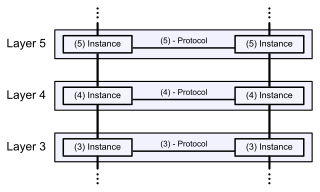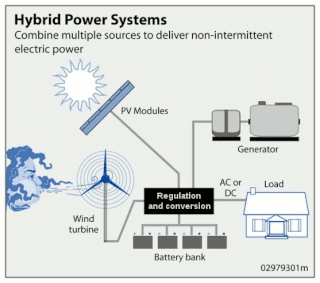
The Open Systems Interconnection (OSI) model is a reference model from the International Organization for Standardization (ISO) that "provides a common basis for the coordination of standards development for the purpose of systems interconnection." In the OSI reference model, the communications between systems are split into seven different abstraction layers: Physical, Data Link, Network, Transport, Session, Presentation, and Application.
ISO/IEC 7816 is an international standard related to electronic identification cards with contacts, especially smart cards, and more recently, contactless mobile devices, managed jointly by the International Organization for Standardization (ISO) and the International Electrotechnical Commission (IEC).

A topic map is a standard for the representation and interchange of knowledge, with an emphasis on the findability of information. Topic maps were originally developed in the late 1990s as a way to represent back-of-the-book index structures so that multiple indexes from different sources could be merged. However, the developers quickly realized that with a little additional generalization, they could create a meta-model with potentially far wider application. The ISO/IEC standard is formally known as ISO/IEC 13250:2003.
The Organization for the Advancement of Structured Information Standards is a nonprofit consortium that works on the development, convergence, and adoption of projects - both open standards and open source - for Computer security, blockchain, Internet of things (IoT), emergency management, cloud computing, legal data exchange, energy, content technologies, and other areas.
LonWorks or Local Operating Network is an open standard for networking platforms specifically created to address the needs of control applications. The platform is built on a protocol created by Echelon Corporation for networking devices over media such as twisted pair, power lines, fiber optics, and wireless. It is used for the automation of various functions within buildings such as lighting and HVAC; see building automation.
ISO/IEC/IEEE 12207Systems and software engineering – Software life cycle processes is an international standard for software lifecycle processes. First introduced in 1995, it aims to be a primary standard that defines all the processes required for developing and maintaining software systems, including the outcomes and/or activities of each process.
EN 50090 is a European standard for Home and Building Electronic Systems (HBES) open communications, issued by CENELEC. It covers any combination of electronic devices linked via a digital transmission network to provide automated, decentralised and distributed process control for domestic and commercial and building applications; for example the control of lighting, heating, food preparation, washing, energy management, water, fire alarms, blinds, security, etc.
IEC 61850 is an international standard defining communication protocols for intelligent electronic devices at electrical substations. It is a part of the International Electrotechnical Commission's (IEC) Technical Committee 57 reference architecture for electric power systems. The abstract data models defined in IEC 61850 can be mapped to a number of protocols. Current mappings in the standard are to Manufacturing Message Specification (MMS), GOOSE [see section 3, Terms and definitions, term 3.65 on page 14], SV or SMV, and soon to web services. In the previous version of the standard, GOOSE stood for "Generic Object Oriented Substation Event", but this old definition is still very common in IEC 61850 documentation. These protocols can run over TCP/IP networks or substation LANs using high speed switched Ethernet to obtain the necessary response times below four milliseconds for protective relaying.
Information security standards are techniques generally outlined in published materials that attempt to protect the cyber environment of a user or organization. This environment includes users themselves, networks, devices, all software, processes, information in storage or transit, applications, services, and systems that can be connected directly or indirectly to networks.
Software asset management (SAM) is a business practice that involves managing and optimizing the purchase, deployment, maintenance, utilization, and disposal of software applications within an organization. According to ITIL, SAM is defined as “…all of the infrastructure and processes necessary for the effective management, control, and protection of the software assets…throughout all stages of their lifecycle.” Fundamentally intended to be part of an organization's information technology business strategy, the goals of SAM are to reduce information technology (IT) costs and limit business and legal risk related to the ownership and use of software, while maximizing IT responsiveness and end-user productivity. SAM is particularly important for large corporations regarding redistribution of licenses and managing legal risks associated with software ownership and expiration. SAM technologies track license expiration, thus allowing the company to function ethically and within software compliance regulations. This can be important for both eliminating legal costs associated with license agreement violations and as part of a company's reputation management strategy. Both are important forms of risk management and are critical for large corporations' long-term business strategies.

A stand-alone power system, also known as remote area power supply (RAPS), is an off-the-grid electricity system for locations that are not fitted with an electricity distribution system. Typical SAPS include one or more methods of electricity generation, energy storage, and regulation.

The smart grid is an enhancement of the 20th century electrical grid, using two-way communications and distributed so-called intelligent devices. Two-way flows of electricity and information could improve the delivery network. Research is mainly focused on three systems of a smart grid – the infrastructure system, the management system, and the protection system. Electronic power conditioning and control of the production and distribution of electricity are important aspects of the smart grid.
IEC 60870 part 6 in electrical engineering and power system automation, is one of the IEC 60870 set of standards which define systems used for telecontrol in electrical engineering and power system automation applications. The IEC Technical Committee 57 have developed part 6 to provide a communication profile for sending basic telecontrol messages between two systems which is compatible with ISO standards and ITU-T recommendations.
Information technology risk, IT risk, IT-related risk, or cyber risk is any risk relating to information technology. While information has long been appreciated as a valuable and important asset, the rise of the knowledge economy and the Digital Revolution has led to organizations becoming increasingly dependent on information, information processing and especially IT. Various events or incidents that compromise IT in some way can therefore cause adverse impacts on the organization's business processes or mission, ranging from inconsequential to catastrophic in scale.
Open Automated Demand Response (OpenADR) is a research and standards development effort for energy management led by North American research labs and companies. The typical use is to send information and signals to cause electrical power-using devices to be turned off during periods of high demand.
IEC 61400 is an international standard published by the International Electrotechnical Commission (IEC) regarding wind turbines.
ISO/IEC JTC 1/SC 27 Information security, cybersecurity and privacy protection is a standardization subcommittee of the Joint Technical Committee ISO/IEC JTC 1 of the International Organization for Standardization (ISO) and the International Electrotechnical Commission (IEC). ISO/IEC JTC 1/SC 27 develops International Standards, Technical Reports, and Technical Specifications within the field of information security. Standardization activity by this subcommittee includes general methods, management system requirements, techniques and guidelines to address information security, cybersecurity and privacy. Drafts of International Standards by ISO/IEC JTC 1 or any of its subcommittees are sent out to participating national standardization bodies for ballot, comments and contributions. Publication as an ISO/IEC International Standard requires approval by a minimum of 75% of the national bodies casting a vote. The international secretariat of ISO/IEC JTC 1/SC 27 is the Deutsches Institut für Normung (DIN) located in Germany.
A distribution management system (DMS) is a collection of applications designed to monitor and control the electric power distribution networks efficiently and reliably. It acts as a decision support system to assist the control room and field operating personnel with the monitoring and control of the electric distribution system. Improving the reliability and quality of service in terms of reducing power outages, minimizing outage time, maintaining acceptable frequency and voltage levels are the key deliverables of a DMS. Given the complexity of distribution grids, such systems may involve communication and coordination across multiple components. For example, the control of active loads may require a complex chain of communication through different components as described in US patent 11747849B2
The Open Smart Grid Protocol (OSGP) is a family of specifications published by the European Telecommunications Standards Institute (ETSI) used in conjunction with the ISO/IEC 14908 control networking standard for smart grid applications. OSGP is optimized to provide reliable and efficient delivery of command and control information for smart meters, direct load control modules, solar panels, gateways, and other smart grid devices. With over 5 million OSGP based smart meters and devices deployed worldwide it is one of the most widely used smart meter and smart grid device networking standards.
An Energy Management System is, in the context of energy conservation, a computer system which is designed specifically for the automated control and monitoring of those electromechanical facilities in a building which yield significant energy consumption such as heating, ventilation and lighting installations. The scope may span from a single building to a group of buildings such as university campuses, office buildings, retail stores networks or factories. Most of these energy management systems also provide facilities for the reading of electricity, gas and water meters. The data obtained from these can then be used to perform self-diagnostic and optimization routines on a frequent basis and to produce trend analysis and annual consumption forecasts.


